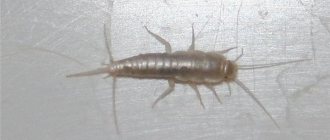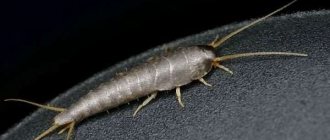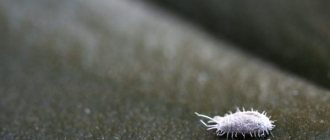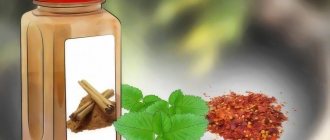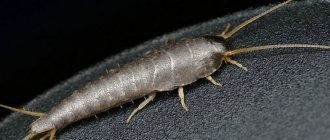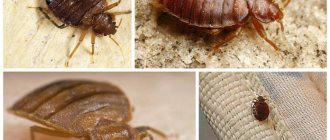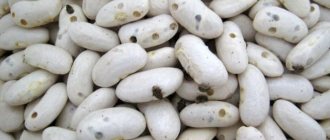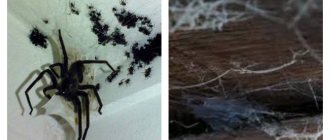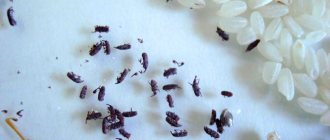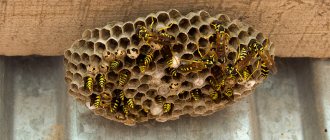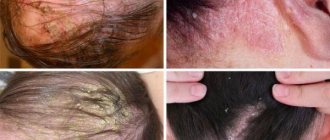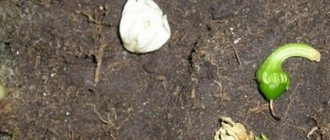37523 0 15
Andrey August 7, 2016Specialization: facade finishing, interior finishing, construction of dachas, garages. Experience of an amateur gardener and gardener. We also have experience in repairing cars and motorcycles. Hobbies: playing the guitar and many other things that I don’t have time for :)
Insects in the bathroom are always an unpleasant surprise, because this room must be kept especially clean and hygienic. In addition, their appearance, as a rule, disgusts people, not to mention the fact that many arthropods are far from harmless. Therefore, in this article I will tell you how to get rid of these little “uninvited guests”.
Arthropods in the bathroom are an unattractive sight
Where do insects come from in the bathroom?
The reasons why insects appear in the bathroom can be divided into two groups:
- External. The source of insect spread may be located in another room, and over time they simply moved to the bathroom. They could also fly or crawl into the room through cracks from the basement, through ventilation pipes from neighbors, or from the street, especially if the house is located near a body of water.
- Internal. In this case, insects appeared in the bathroom due to the formation of an appropriate microclimate. The main reasons for this phenomenon are high humidity or temperature and unsanitary conditions. Having correctly established the cause, it will be easier to deal with its consequences.
Note! A frequent cause of changes in the microclimate is a small but continuous leak in the pipe under the bathtub, causing the development of increased dampness.
Dampness and mold are the most common causes of insects in the bathroom.
The bathroom is a favorable habitat for insects for the following reasons:
- high humidity;
- availability of food and water;
- almost constant absence of people;
- lack of daylight, which is uncomfortable;
- no pets.
Most often, insects live in the following places:
- hard-to-reach places such as hidden communications and far corners;
- water pipes, which are places where condensation accumulates;
- dusty areas, such as shelves, under-bathtub floors, and cabinets;
- wet hygiene products - washcloths, sponges, towels, floor mats, etc.;
- constantly wet vessels and jars with gels, shampoos, balms and other things.
Most often, the habitats of insects in the bathroom are pipes, cracks, and hard-to-reach corners.
Why are they dangerous and harmful?
In essence, most of the possible inhabitants of the bathroom do not pose a real threat to humans, bringing only psychological discomfort. However, most of them can be carriers of various diseases dangerous to humans. A small part can also bite or sting, which is not only painful, but can also cause the development of allergies.
In any case, you should not ignore the appearance of such living creatures, as they are prone to rapid reproduction and can easily spread to other rooms.
Note! The appearance of insects also precedes the formation of another, not very pleasant problem - mold. It almost always spreads around the room following the living creatures.
The most dangerous is black mold.
What insects may appear
White bugs
Before you fight white insects in the bathroom, you need to understand what they are. Silverfish are white, light gray or silver in color. They have a small, up to 10 mm, elongated body, 12 pairs of legs and three hairs at the posterior end of the body.
The presence of water and food are the main reasons for the appearance of white bugs in the bathroom.
Until the third moult, they retain their black color and are smaller in size. They are not carriers of infections, do not emit allergens and do not bite. They reproduce rather slowly, but move quickly, so it is difficult to catch them.
In their natural environment, they feed on plant matter that contains starch and polysaccharides. In an apartment, food for them can be:
- flour;
- starch;
- sugar;
- book binding;
- wallpaper glue;
- fabrics containing starch;
- photos;
- children's and natural cosmetics.
This is what silverfish looks like.
Thus, the only danger of silverfish for humans is damage to property, including memorable ones. Also, food products can be contaminated with the remains of their vital activity or eggs.
Woodlice
During the molting period, woodlice acquire a transparent or white color, and therefore they are sometimes confused with silverfish. The rest of the time they have a gray or brown shell color, sometimes with camouflage spots. These are crustaceans with a convex back, covered with a chitinous shell of seven plates, seven pairs of limbs and two pairs of antennae, one of which is underdeveloped. Part of the head is hidden under the shell and has eyes located on the sides. Body length does not exceed 20 mm.
In their natural environment, woodlice feed on organic debris such as fallen fruits and leaves, and rotten roots. As numbers increase, healthy plants can also be attacked. In human housing they eat the following:
- organic residues found in the trash can;
- crumbs and particles of skin in dust, fallen flowers and leaves of indoor plants;
- rotten vegetables in basements and cellars;
- mold spores that form in the bathroom with increased humidity.
For crustaceans, a warm (23-25°C), dark and damp place is preferable, so the bathroom is perfect. They can only settle in places where sanitary standards regarding air humidity are violated, which is especially important for the lower and outer floors. They enter homes through cracks in attics and basements.
Most often, woodlice settle in the bathroom or kitchen.
Woodlice do not pose a threat to humans, as they do not carry infections and do not bite. However, when their paws come into contact with the skin, irritation may occur. When they appear, you should be wary of your plants and vegetable supplies, as these active crustaceans with a high reproduction rate can be unusually active.
Worms
Thin worms of a pale or pale pink hue, up to 50 mm long, are called tubifex worms. They love warmth and dampness, feeding on decaying particles of stagnant water.
They live in large colonies and can appear in the bathroom along with water that is pumped from the pond. There they live in silt and other contaminated places, and therefore have little chance of getting into the water supply system. If this does happen, then the worm can be used as food for aquarium fish or simply washed off.
It is best to get rid of worms using chemical means.
They are often almost the main food for the inhabitants of home aquariums, as they purify the water from contaminants. However, in places where human hygiene procedures are carried out, they can pose a danger, as they are capable of accumulating and transporting toxic substances over the surface. Tubifex also absorb substances with anaerobic bacteria, and therefore are carriers of pathogenic microflora.
Centipedes
There are several species of this class of arthropods, but bathrooms are usually inhabited by lipopods called cutigers. They have a flattened body, divided into several segments, along which long legs are located. The length of the body can reach 60 mm, the shell is light brown or gray, covered with blue or purple stripes. On the head there are compound eyes, as well as antennae measuring half the length of the body.
They live mainly in rotten leaves, but with the onset of cold weather they move to humid and warm places. They are active at any time of the day, hunt using their vision and develop enormous speed. Worms, larvae and flies are used as food sources, which is why their popular name - flycatchers - appeared.
The flytrap is harmless to humans, but not every housewife will like its presence in the house.
Thanks to the destruction of other living creatures, centipedes are even considered useful inhabitants, especially considering that they do not spoil paper, furniture or wood and do not feed on waste.
Nevertheless, scutigers pose a danger to humans, since as a defensive behavior they can bite through the skin and inject poison. It causes redness of the skin, swelling and itching. This does not cause any particular harm to health, but causes severe, mainly psychological, discomfort.
To prevent this insect from appearing in the house, it is necessary to prevent the appearance of high humidity and the accumulation of damp things. Also pay special attention to frequent ventilation of the room.
Butterflies
Butterflies are dipterous insects that resemble moths in appearance. They are distinguished by small hairs covering the wings and body, making them appear velvety. The body size is from one to four millimeters, the color is most often steel or silver.
They are also attracted to dampness in bathrooms. Colonies can be quite numerous, but most of them remain in basements, where larvae develop in sewer pipes, in places where dirt and constant condensation accumulate. Butterflies do not cause harm to people or household items, but they are a nuisance to pets.
Butterfly flies are tiny midges measuring 3 to 5 mm in length.
Other pests
Less common insects are the following:
- mosquitoes and their larvae;
- sewer beetle;
- spiders, ants and midges;
- beetles, or flour beetles;
- cockroaches.
flycatcher
It is also called the house centipede. This insect is large in size and has a repulsive appearance, which instills real horror in some people. But in fact, this is a peaceful and even useful creature, since it feeds on other, smaller insects.
The house centipede reaches a length of 6 centimeters. It can be either gray or brown. There are 3 longitudinal bluish stripes on the back. The legs are very long, especially the last pair - they could easily be confused with a mustache. The number of legs increases as the insect grows.
A young flycatcher has 4 pairs of legs, corresponding to the number of body segments. An adult already has 15 pairs. Their eyes provide them with remarkable vision. Using its long legs, the flycatcher runs very quickly.
Flycatchers live up to their name because they feed on other household insects - they destroy cockroaches, flies, spiders and other uninvited inhabitants of our apartments. In fact, this is the most useful insect that can be found in the house.
Flycatchers are very good hunters. They can remain motionless on the wall for hours. Having discovered the victim, they quickly rush at it, inject a portion of poison, and then eat it. Sometimes a flycatcher catches two insects at once, then it eats them in turn, holding the next victim with its legs.
It must be said that the house centipede is a poisonous insect, and sometimes it can even bite a person, but its poison is completely harmless to people. This happens rarely and only as a defense. At the bite sites, a person may experience a slight burning sensation for some time.
Centipedes appear in our apartments, like other insects, from neighbors or from the street. They are attracted to houses with high humidity, and, of course, they will only stay where there is enough food for them. Therefore, the appearance of these insects can be expected where other insects have already bred. Basically, centipedes live in private buildings, but they can often be found in city apartments.
As already mentioned, flycatchers are harmless, but most people do not want to tolerate their presence due to their appearance. Standard methods of removing insects are unlikely to be effective against them, since they lead a special lifestyle, feeding only on other insects.
Glue traps are also ineffective against them, because the centipede has many legs, and if it sticks to the glue composition, it will calmly tear off the stuck limbs, they will then grow back. To prevent their occurrence, the usual methods are used - maintaining order, sealing cracks, etc.
Fighting methods
Physical methods
These control methods include the following:
- Carrying out general cleaning. It is necessary to remove all debris and all existing objects from the bathroom, remove condensation deposits, dust and dirt in all hard-to-reach corners.
- Treatment of the premises. First, bleach or another disinfectant is used, after which it is necessary to apply a solution of copper sulfate.
- Reduce indoor humidity. This can be done by regular ventilation, as well as drying using electrical appliances.
When cleaning, pay special attention to the most inaccessible places, pipes, cracks, corners.
Note! To prevent insects from returning to the bathroom, it is necessary to ensure that the ventilation and heating systems are always working well so that the air is sufficiently dry. In case of interruptions in the hot water supply or heating system, you can install an electric heated towel rail or a forced ventilation system.
Ventilate the bathroom as often as possible.
Traps and bait
The most common types of traps are the following:
- Electrical mechanisms. They attract insects with a special aroma or artificially created humidity, and then kill them with a strong discharge.
- Adhesive plates. Animals are attracted by light, bait or special chemicals. Once on the plate, it sticks and cannot be freed, dying after a while.
- Boxes with valves. These are miniature traps that have a damp and dark space inside. The insect crawls into them, but because of the protective membrane it cannot get out.
- Wet birch broom. It is installed in the corner of the bathroom at night, and in the morning it is taken out of the room and thrown away or burned.
- Glass jars. Their outer surface is wrapped with paper or tape with a rough texture. The insect will climb up it without any problems and get into the jar, but the sliding glass will prevent it from getting out. You can place a little sugar or fruit at the bottom of the jar as bait.
- Paper. A roll of toilet paper or paper napkins is moistened with water and left overnight. The next morning it is thrown away or burned in a curled state. This method will be most effective in the fight against silverfish, since they not only love moisture, but also eat paper.
These types of insect extermination are the safest.
Chemicals
The most effective control method that gives lasting results with regular treatment. It is better to carry out disinfestation throughout the entire apartment, since insects can spread beyond the bathroom. The most popular and effective aerosols include the following:
- Mosquitall;
- Raptor;
- Antimol;
- Combat;
- Raid;
- Dichlorvos;
- Clean house;
- Extramit;
- Armol.
Important! It is necessary to process the room wearing thick rubber gloves, safety glasses, a respirator or mask.
After treatment, the room is closed for the time specified in the instructions, after which it is ventilated and subjected to wet cleaning. Particular attention should be paid to washing surfaces that come into contact with hands.
Dichlorvos is the most time-tested remedy. Now on store shelves you can find not only those without an unpleasant odor, but even flavored options.
Folk remedies
The most well-known means are the following:
- Diatomite, or kieselguhr earth. This is a rock with abrasive properties and high absorption. This insecticide is scattered in dark areas and corners of the bathroom. After contact with it, the lipids included in the chitinous layer of insects are destroyed, and they die.
- Orthoboric acid. This is a powder that causes paralysis when ingested by an insect. It is diluted in water or mixed with boiled yolk, after which cracks, pipes and cracks are treated with a solution or paste.
- Clove seeds or zest. They are placed around the perimeter of the room and in communication nodes, which causes the silverfish to escape.
Boric acid can be found in any pharmacy. The price of this product is not high, but the effectiveness is excellent.
Spider
Spiders are arthropods. Everyone knows that they weave webs to catch their victims. Of course, in good autumn weather, a spider's web can look very beautiful, but only if it is located outside. No one will like a web woven by a house spider in an apartment. Although spiders bring a certain benefit - they catch flies, their presence in the apartment is extremely undesirable for aesthetic reasons.
Spiders have 4 pairs of very long legs, each of which is several times larger than the size of the body. The cephalothorax and abdomen are connected by a thin thread. Body size can reach 20 centimeters. There are no teeth; spiders successfully replace them with curved jaws; they have channels through which poison enters.
When the spider overtakes the victim, it injects a portion of poison into it along with digestive juice. After some time, it turns the victim’s insides into slurry, which the spider happily sucks out.
At one time, the very distant ancestors of spiders climbed out of the water onto land. They did not start weaving webs right away; this was the result of a number of evolutionary transformations. To weave webs, spiders have channels in the back of their abdomen that secrete special secretions. When the secretion is removed from the spider's body, it instantly freezes, turning into a thread. Spiders need webs for several purposes:
- With its help, they catch various insects that they feed on.
- Spiders live in webs.
- In it they also weave cocoons in which the eggs mature.
- Spiders also use webs to travel long distances.
When the web breaks, the spider eats it and processes it into secretion. The web seems airy in appearance, but in fact it is a fairly strong structure, which not every insect can tear.
Spiders use 2 types of threads - sticky and without adhesive. The latter option is used by them for movement. But the spider will not stick even to a sticky web, since a substance that prevents sticking is formed on the surface of its legs.
Usually, 2 types of these animals live in our apartments:
- house spider;
- pigtail spider.
They can get into the apartment any way they want - they can be carried on clothes, or they can crawl in on their own. The presence of a large number of spiders indicates that the sanitary situation in it is not at the highest level.
Spiders are always where there is a lot of food for them - flies, cockroaches and other parasites. It is generally accepted that a spider brings good luck, but this is just a belief, and in fact, spiders are a consequence of unfavorable sanitary conditions in housing.
Features of disinfection in the bathroom
Cleaning and disinfection in the bathroom should be carried out according to the following plan:
- Elimination of excess. Hygiene products are placed in a basin, a rug and towels are placed in the wash, and the curtain is soaked in a soapy solution.
- Washing tiles. Apply the detergent using a sponge to the dampened surface of the walls. An anti-mold spray can be used to clean tile joints.
- Pipe cleaning. A thick pipe cleaning gel is poured into the drain holes to remove dirt and blockages.
- Cleaning the toilet and bathtub. The cleaning agent is applied to the surface of the bathtub for a while and then washed off. Water is removed from the toilet, then the lid, walls and surface under the rim are washed. For disinfection, the product is left on the surface and then removed.
- Cleaning mirrors. Wash with detergent and wipe with a soft cloth.
- Washing the floor. The floor is washed with a disinfectant, then rinsed with clean water and wiped.
Note! For cleaning, you must choose products without abrasives.
Very often we just clean the bathroom, but forget about disinfection.
Prevention of insects
To prevent the appearance of bugs in the bathroom, the following measures are taken:
- maintaining cleanliness in the premises;
- removal of dust and condensate on pipes;
- installation of high-quality ventilation and periodic cleaning of mines;
- eliminating cracks and holes in walls, on the floor and near baseboards;
- quick repair of taps in case of leakage;
- drying wet corners using a fan heater;
- treatment with chlorine and drying of places where mold has begun to appear;
- regularly checking cereal stocks and thoroughly removing crumbs;
- timely removal of garbage and food waste.
Good ventilation will ensure a comfortable microclimate in the room.
If insects appear in the bathroom due to dampness, then this is not a reason to panic. Getting rid of living creatures does not require serious effort, but a responsible approach to compliance with sanitary and hygienic standards will avoid such an encounter.
Conclusion
Insects living in the bathroom and toilet sometimes do not pose much of a threat. Some species (spiders, butterflies) practically do not reproduce and are encountered occasionally.
However, getting rid of the rest can be difficult. If measures are not taken, the size of the colony will increase, insects will hide in cracks and pipes and move to other rooms.
It is important to follow preventive measures and maintain normal temperature and humidity levels, otherwise pest control will be delayed. Create conditions unsuitable for insect life.
Remove food (paper, cloth, trash), eliminate sources of moisture (condensation, towels, leaks) and reduce temperature to 20°C or lower.
